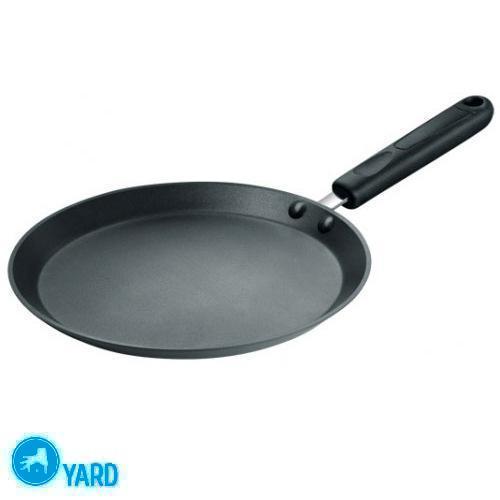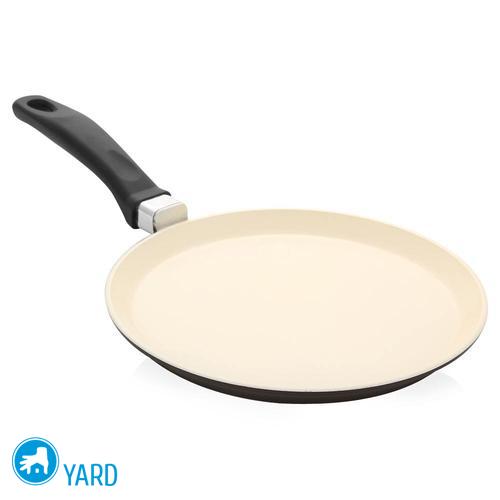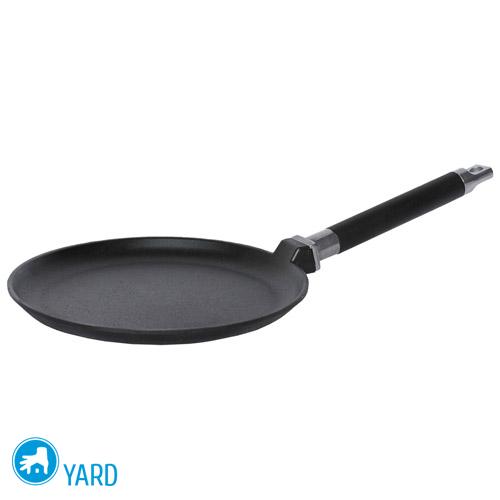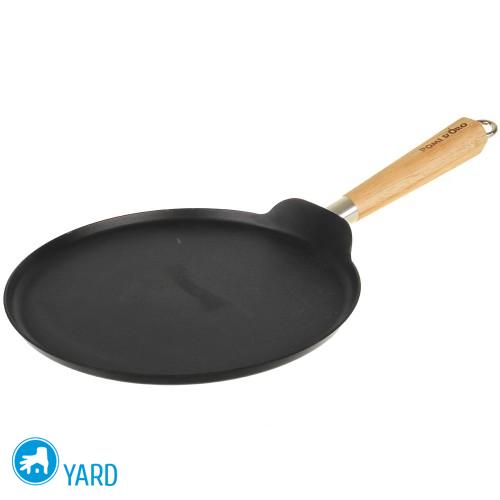Pancake pan with all the details
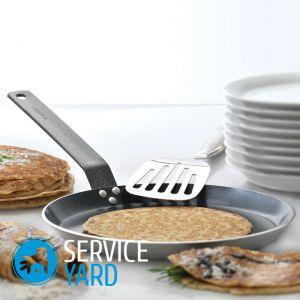
The most delicious, rosy and fried pancakes appeared in world culinary for a long time. In those days, pancakes were baked on simple metal sheets and they were almost no different from cakes. But only with the advent of pans, the preparation of golden, thin, evenly fried, juicy pancakes became simple and affordable for housewives. In any home there should be a special solid pancake pan, because high-quality, convenient dishes are the key to a tasty, appetizing and beautiful dish. Despite the abundance and variety of kitchen utensils in stores, few know how to choose the perfect pan for pancakes so that it will delight you and household with thin, lace pancakes for many years.
to contents ↑Which pancake pan is better?
Many housewives, out of habit, fry pancakes in pans inherited from grandmothers and mothers. But if you didn’t pass on such solid dishes, then choose a pan, following simple, but very important rules.
An ideal pan should have:
- Low sides.
- Perfectly flat bottom surface (without relief and sloping transitions).
- Long handle.
- Thick bottom allowing the dough to warm evenly.
to contents ↑Important! The material of the pan must ensure an even distribution of heat.
The size of the utensils only affects usability. For example:
- thin pancakes with a diameter of 15-16 cm are easier to turn over and bake faster,
- large - with a diameter of 20 cm can be folded several times and stuffed with any fillings.
Pancake pan materials
During cooking, the pan is subjected to severe thermal shock when cold dough is poured over a very hot surface. Therefore, not all utensils can withstand this. Therefore, when deciding which pancake pan is better, first of all pay attention to the material from which it is made. Consider the types of pancake pans, as well as their advantages and disadvantages.
to contents ↑Important! The following types of pans for pancakes:
- Cast iron.
- Aluminum
- With non-stick coating.
- Copper.
- Ceramic coated.
- With marble finish.
Cast Iron Pans
Our mothers and grandmothers, such a pancake pan was an absolute favorite. And today, many housewives give preference to just such a dish, as it has a lot of advantages.
Important! The first cast iron cookware appeared in the 3rd century BC. in China, and to this day, the material pleases with its strength and reliability.
Benefits:
- Reliability.
- Durability.
- The ability to evenly distribute heat over the entire surface.
- Safety for health.
- Excellent thermal inertness - the cast-iron pancake pan slowly heats up and cools for a long time, which allows you to quickly bake pancake dough.
- Excellent baking qualities - thanks to the thick bottom, pancakes acquire a unique taste and a golden color.
- It does not deform from overheating.
- Porous structure - during frying, an oil film forms on the porous structure, which makes pancakes easy to turn over.
- Profitability - based on the previous advantage, there is no need to lubricate the surface every time before the next preparation.
- Thick bottom and walls.
- Ability to use on any stove.
- Compatibility with any devices and accessories - during cooking and turning dishes, you can use any devices made of various materials without fear of scratching the surface.
Disadvantages:
Although the cast-iron frying pan is one of the “long-livers”, it also has a number of disadvantages:
- Heavy. The smallest pancake pan with low sides weighs several kilograms.
- Doesn't like moisture. From exposure to water, rust often appears on cast iron utensils.
- Requires special care.
- Price. A good quality cast-iron pancake pan is not cheap, but the costs pay off due to the long service life.
- The need for pre-training. A new pan will have to be prepared for use - first calcine, and then grease.
Selection and Care Tips
Going to the store to choose a pan for pancakes, pay attention to:
- Surface quality - it should be smooth, without chipping and other defects. The roughness should be barely noticeable.
- Beads - they should be low (1-2 cm) - select the size according to your favorite pancake diameter. But remember, the less the utensils, the easier it is.
Preparation for operation
Process the new cast-iron pan as follows:
- Rinse with warm, soapy water.
- Wipe dry.
- Put on fire.
- Pour ordinary rock salt into the pan.
- Anneal the pan over high heat for an hour (stir the salt occasionally).
- Repeat the procedure again for reliability. By the end of the calcination, the salt will pull out all the fumes and technical oils used in the smelting of cast iron.
- Wash the items in warm water and soapy water.
- Dry the pan thoroughly.
- Pour 100-150 ml of refined vegetable oil.
- Anneal the pan.
- Turn off the heat and let the utensils cool.
- Drain the oil - it can no longer be used.
- Rinse the pan in warm water.
Important! During this treatment, a thin oil film forms on the surface of the utensil, and it is very important not to damage it. Do not clean the pan with rough sponges and brushes during preparation.
Care Rules
If you use a cast-iron skillet only for baking pancakes, then take care of it as follows:
- After frying, pour a little oil and add 2-3 tbsp. tablespoons of coarse salt.
- Heat the cookware over medium heat and drain the oil.
- Wait - let the pancake pan cool.
- Wipe the bottom with a napkin or a clean, dry cloth.
Frying pan aluminum and its main features
Food grade aluminum is a fairly safe material and lightweight. Aluminum was known for a long time - even before our era.
Important! Historians claimed that when the emperor of Rome, Tiberius, a jeweler brought an elegant light plate, similar to a silver one, the crown bearer, fearing that the gold would depreciate, ordered the jeweler to be chopped off. Again, aluminum appears in the 19th century and now for a long time.
Pros:
- Light weight.
- Minimal preparation before use.
- Cheapness.
Important! The aluminum pan is very light due to the fact that it has high thermal conductivity. That is why heating it takes a couple of minutes.
Kinds
A pancake pan made of food-grade aluminum, which is coated with a special protective layer, such as in the case of copper utensils, is very popular today.
A pancake pan made of aluminum can be thin, medium or heavy cast with a thick bottom and the same walls.
Important! We recommend choosing exceptionally thick pans, as they are more durable, heat up quickly and keep heat for a long time. In addition, keep in mind that the pancake pan should have low sides.
Minuses
Even thick aluminum pans have disadvantages, in particular:
- Toxicity if the protective layer is damaged.
- Cooling fast.
- Subject to deformation. Aluminum is susceptible to mechanical damage.Therefore, in the process of turning the pancakes, use only a wooden spatula.
- It is necessary to constantly lubricate with oil during cooking. If the pancakes burn, then you have not added oil or it is not warm enough.
to contents ↑Important! Aluminum utensils do not require special care and preparation. New aluminum pan:
- Wash thoroughly in warm water with detergent, and then in running water.
- Dry with a paper towel or cloth.
- Preheat and add a little oil before cooking.
- As soon as the haze appears - start baking pancakes.
Non-stick products - features of operation
The most modern option is pancake teflon-coated pan, which makes the product non-stick. There are a great many types of coatings, and it can be applied to any metal surface: steel, aluminum, other alloys.
Important! Usually, the material affects the price and weight of the product, but the quality of the coating is very important.
Teflon
Many people blame cheap Teflon for toxicity, but the safety of an expensive and certified coating has not yet been proven. Whether to give preference to just such a dish is not up to you.
pros
The obvious advantages of non-stick pans include:
- Lightning-ready for work.
- Low oil consumption.
- Simple care.
- Low price.
- Easy to use.
Minuses
The disadvantages of the product include:
- Recommended heating temperature 200-220 degrees. The coating does not respond well to overheating - due to the very high temperature, Teflon may crack and begin to evaporate.
- The need for respect for non-stick coating. Wash utensils with hard brushes and do not use abrasive detergents.
- The need to use special polymer or wooden devices. All metal objects: forks, knives must be kept away from fragile coating.
Helpful hints:
- A non-stick pancake pan should have a thick bottom, low sides and a comfortable handle. To decide which pan is better for pancakes, give preference to the one whose edges and walls are thicker so that over time the pan does not lose shape and does not bend.
- A cover for a pancake pan is not needed.
- Select the diameter and size according to your preference.
- Always control the power of the fire. Recently, products have appeared with a heat-sensitive indicator - a thermal spot, which changes color as soon as the time comes to bake pancakes.
- Despite the fact that a special coating is applied to the pan, oil is still necessary for making pancakes. Firstly, pancakes will not be overdried, and secondly, this will extend the life of the product.
- Since the pancake pan with non-stick coating does not tolerate temperature differences, after cooking, allow the pan to cool, and then wash.
Ceramic coating
Ceramics as a non-stick coating is distinguished by its reliability and environmental friendliness. Externally, this product is a cast aluminum frying pan with a smooth frying surface of a dark or light color, in contrast to a teflon rough.
pros
The main advantages of such models are:
- High non-stick properties.
- Durability.
- Harmless and safe - ceramics do not emit harmful substances, even if the top layer is scratched.
- Easily tolerates heat.
- Ease of care.
- More scratch resistant.
Minuses
Ceramics also have disadvantages:
- The price is higher than that of Teflon products.
- Fragility.
- It does not tolerate sudden changes in temperature - do not put a hot pan under cold water, this will damage the coating.
Helpful hints:
- If you decide to choose a pan for pancakes with ceramics, be careful, because often ceramics are given an aluminum product with a thin layer of enamel. Such a model is short-lived, moreover, it is toxic.
- Each manufacturer recommends using certain accessories with ceramic products. Someone - only wooden shovels, and other products can also carry iron scrapers.
- Before the first frying, thoroughly wash the new ceramic pan and wipe it with a clean cloth. Then, heat over medium heat and add a small amount of oil. Lightly bake over low heat, evenly distributing the oil over the surface. The ceramic coating absorbs oil, and in such a pan in the future it will be possible to fry without it.
- After use and cooling, wipe the ceramic with a sponge and warm water. Do not leave the pan not washed, as this reduces its service life.
Marble coating
Marble is a new word in the manufacture of tableware. The new technology has been mastered so far only by leading world companies. Marble coating is a logical continuation of the ceramic material as a frying surface. Although manufacturers do not reveal the secret of the new technology, in the product descriptions it is mentioned that natural marble and granite are used in the manufacture of non-stick coatings.
Important! Marble dishes are cast aluminum pans with a thick bottom and a non-stick coating of light color, which includes natural marble.
Advantages:
- The surface warms up quickly and evenly.
- Scratch resistant.
- Not toxic.
- Even without oil, pancakes do not burn.
- Spectacular look.
Disadvantages:
- High price.
Helpful hints:
- The care for marble-coated pans is the same as for pottery. However, the marble coating does not require calcination.
- High-quality marble is very difficult to scratch, but manufacturers still advise using soft appliances made of wood and polymers directly during cooking.
Copper Pancake Pan
Copper ware is one of the oldest on the planet and is still in demand among professional chefs. However, to choose just such a pan for pancakes is unlikely to occur to a housewife. The reasons for this are very important disadvantages.
Minuses:
- High price.
- The difficulty of caring for copper utensils.
Important! The disadvantages, in addition to the price, include the need for a mandatory oil refill during each frying.
Pros:
- Thermal inertness - such a pancake pan holds heat very well.
- Excellent heat-conducting qualities - heats up quickly, heats up evenly.
- Convenient weight is much lighter than a cast iron product, but not as light as aluminum.
- Quality and reliability.
How to choose a pan for pancakes?
If you have decided on the material of the dishes, then before buying, listen to the following recommendations:
- The height of the sides should not exceed 1 cm - this ensures ease of turning. Some designer models have sides from 2 mm to 10 mm.
- Handle length is not only safety. A cast-iron or copper frying pan is always full of splashes of hot oil, so choose a handle more authentic for such models.
- Choose dishes with a handle that does not heat up, otherwise you will have to work with a tack, which is not very convenient. Do not forget that plastic handles melt over the fire, so prefer wooden.
- The bottom should be thick and even. The thicker the bottom, the longer the pan will last.
- Choose the shape of the dishes according to your preference. Take a closer look at the square pans, especially if you like to stuff pancakes: wrapping the filling in a square pancake is more convenient. If there are children in the house, then choose curly dishes with pictures or hearts.
Stock footage
We hope that thanks to this article, you have found the answer to the question which pan is better for pancakes. It remains only to go to the store for a purchase, and let not a single pancake be “lumpy" at you.
- How to choose a vacuum cleaner taking into account the characteristics of the house and coatings?
- What to look for when choosing a water delivery
- How to quickly create comfort at home - tips for housewives
- How to choose the perfect TV - useful tips
- What to look for when choosing blinds
- What should be running shoes?
- What useful things can you buy in a hardware store
- Iphone 11 pro max review
- Than iPhone is better than Android smartphones



